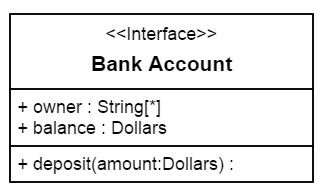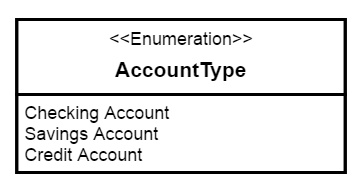UML Class Diagram Shapes
5 Jan 202124 minutes to read
Class diagram is used to represent the static view of an application. The class diagrams are widely used in the modelling of object oriented systems because they are the only UML diagrams which can be mapped directly with object oriented languages.
Diagram supports to generate the class diagram shapes from business logic.
The UML class diagram shapes are explained as follows.
Class
-
A Class describes a set of objects that shares the same specifications of features,constraints and semantics.To define a class object, you need to define the classifier as “class”.
-
Also, you need to define the name, attributes and methods of the class using the class property of node.
-
The attribute’s name, type and scope properties are allows you to define the name, data type and visibility of the attribute.
-
The method’s name, arguments, type and scope properties are allows you to define the name, argument, return type and visibility of the methods.
-
The method.arguments object properties name and type allows to define the name and type of the argument.
The following code example illustrates how to create a class.
$("#diagram").ejDiagram({
width: "100%",
height: "100%",
pageSettings: {
scrollLimit: "diagram"
},
nodes: [{
name: "Patient",
offsetX: 100,
offsetY: 100,
borderWidth: 2,
borderColor: "black",
//Sets type of shape
type: "umlclassifier",
//Sets the type of classifier
classifier: ej.datavisualization.Diagram.ClassifierShapes.Class,
//Sets the class object
"class": {
//Name of a class header
name: "Patient",
//Sets the collection of attributes
attributes: [{
name: "accepted",
type: "Date",
//sets the scope value for class member
scope:"protected"
},
{
name: "prescription",
type: "String[*]"
}],
//Sets the collection of methods
methods: [{
name: "getHistory",
//sets the arguments for methods
arguments: [{
name: "Date"
}],
type: "History" }]
},
}]
});
NOTE
The default value for the property
classifieris “class”.
Interface
-
An Interface is a kind of classifier that represents a declaration of a set of coherent public features and obligations. To create an interface, you need to define the classifier property as “interface”.
-
Also, you need to define the name, attributes and methods of the interface using the interface property of the node.
-
The attribute’s name, type and scope properties are allows you to define the name, data type and visibility of the attribute.
-
The method’s name, arguments, type and scope properties are allows you to define the name, argument, return type and visibility of the methods.
-
The method.arguments object properties name and type allows to define the name and type of the argument.
The following code example illustrates how to create an interface.
$("#diagram").ejDiagram({
width: "100%",
height: "100%",
pageSettings: {
scrollLimit: "diagram"
},
nodes: [{
name: "Bank",
offsetX: 100,
offsetY: 100,
borderWidth: 2,
borderColor: "black",
//Sets type of shape
type: "umlclassifier",
//Sets the type of classifier
classifier: ej.datavisualization.Diagram.ClassifierShapes.Interface,
//Sets the interface object
interface: {
name: "Bank Account",
attributes: [{
name: "owner",
type: "String[*]"
},
{
name: "balance",
type: "Dollars"
}],
methods: [{
name: "deposit",
arguments: [{
name:"amount",
type:"Dollars"
}],
}]
},
}]
});
Enumeration
-
To define an enumeration, you need to define the classifier property of node as “enumeration”. Also you need to define the name and members of the enumeration using the enumeration property of node.
-
You can set a name for the enumeration members collection using name property of members collection.
The following code example illustrates how to create an enumeration.
$("#diagram").ejDiagram({
width: "100%",
height: "100%",
pageSettings: {
scrollLimit: "diagram"
},
nodes: [{
name: "Enums",
offsetX: 100,
offsetY: 100,
borderWidth: 2,
borderColor: "black",
//Sets type of shape
type: "umlclassifier",
//Sets the type of classifier
classifier: ej.datavisualization.Diagram.ClassifierShapes.Enumeration,
//Sets the enumeration object
enumeration:{
name: "AccountType",
//sets the members of enumeration
members: [{
name: "Checking Account"
},
{
name: "Savings Account"
},
{
name:"Credit Account"
}
]}
}]
});
Connector Shapes
- The connector shape property defines the role/meaning of the connector.
- The different types of connector shapes are BPMN, UMLClassifier and UMLActivity and can render these Shapes by setting connector shape type property.
- The type of flow shapes in a BPMN process are sequence, association and message.
Relationships
A relationship is a general term covering the specific types of logical connections found on class diagrams.
The list of relationships are demonstrated as follows.
| shape | Image |
|---|---|
| Association |  |
| Aggregation |  |
| Composition |  |
| Inheritance |  |
| Dependency |  |
Association
Association is basically a set of links that connects elements of an UML model. The type of association are as follows.
- Directional
- BiDirectional
The association property allows you to define the type of association. The default value of association is “Directional”. The following code example illustrates how to create an association.
$("#diagram").ejDiagram({
width: "100%",
height: "100%",
pageSettings: {
scrollLimit: "diagram"
},
connectors: [{
name: "connect1",
sourcePoint:{
x:100,
y:200
},
targetPoint:
{
x:300
,y:200
},
segments: [{
type: "straight"
}],
shape: {
type: "umlclassifier",
//Sets the type of the relationships as association
relationship: ej.datavisualization.Diagram.ClassifierShapes.Association,
//Sets the type of association
association: ej.datavisualization.Diagram.AssociationFlows.Directional,
}
}]
});
NOTE
The default value for the property
associationis “directional”.
Aggregation
Aggregation is a binary association between a property and one or more composite objects which group together a set of instances.
Aggregation is decorated with a hollow diamond. To create an aggregation shape, you need to define the relationship as “aggregation”.
The following code example illustrates how to create an aggregation.
$("#diagram").ejDiagram({
width: "100%",
height: "100%",
pageSettings: {
scrollLimit: "diagram"
},
connectors: [{
name: "connect1",
sourcePoint:{
x:100,
y:200
},
targetPoint:
{
x:300
,y:200
},
segments: [{
type: "straight"
}],
shape: {
type: "umlclassifier",
//Sets the type of the relationships as aggregation
relationship: ej.datavisualization.Diagram.ClassifierShapes.Aggregation,
}
}]
});
Composition
Composition is a “strong” form of “aggregation”. Composition is decorated with a black diamond.
To create a composition shape, define the relationship property of connector as “composition”.
The following code example illustrates how to create a composition.
$("#diagram").ejDiagram({
width: "100%",
height: "100%",
pageSettings: {
scrollLimit: "diagram"
},
connectors: [{
name: "connect1",
sourcePoint:{
x:100,
y:200
},
targetPoint:
{
x:300
,y:200
},
segments: [{
type: "straight"
}],
shape: {
type: "umlclassifier",
//Sets the type of the relationships as composition
relationship: ej.datavisualization.Diagram.ClassifierShapes.Composition,
}
}]
});
Dependency
Dependency is a directed relationship which is used to show that some UML elements needs or depends on other model elements for specifications. Dependency is shown as dashed line with opened arrow.
To create a dependency, you need to define the relationship property of connector as “dependency”.
The following code example illustrates how to create an dependency.
$("#diagram").ejDiagram({
width: "100%",
height: "100%",
pageSettings: {
scrollLimit: "diagram"
},
connectors: [{
name: "connect1",
sourcePoint:{
x:100,
y:200
},
targetPoint:
{
x:300
,y:200
},
segments: [{
type: "straight"
}],
shape: {
type: "umlclassifier",
//Sets the type of the relationships as dependency
relationship: ej.datavisualization.Diagram.ClassifierShapes.Dependency,
}
}]
});
Inheritance
Inheritance is also called as “generalization”. Inheritance is a binary taxonomic directed relationship between a more general classifier(super class) and a more specific classifier(subclass).
Inheritance is shown as a line with hollow triangle.
To create a inheritance, you need to define the relationship as “inheritance”.
The following code example illustrates how to create an inheritance.
$("#diagram").ejDiagram({
width: "100%",
height: "100%",
pageSettings: {
scrollLimit: "diagram"
},
connectors: [{
name: "connect1",
sourcePoint:{
x:100,
y:200
},
targetPoint:
{
x:300
,y:200
},
segments: [{
type: "straight"
}],
shape: {
type: "umlclassifier",
//Sets the type of the relationships as inheritance
relationship: ej.datavisualization.Diagram.ClassifierShapes.Inheritance,
}
}]
});
Multiplicity
Multiplicity is a definition of an inclusive interval of non-negative integers to specify the allowable number of instances of described element. The type of multiplicity are as follows.
- OneToOne
- ManyToOne
- OneToMany
-
ManyToMany
- By default the multiplicity will be considered as “OneToOne”.
-
multiplicity property in UML allows to specify large number of elements or some collection of elements.
-
The shape.multiplicity’s source property used to set the source label to connector and target property used to set the target label to connector.
-
To set an optionality/cardinality for the connector source label, use optional property.
- lowerBounds and upperBounds could be natural constants or constant expressions evaluated to natural (non negative) number. Upper bound could be also specified as asterisk ‘*’ which denotes unlimited number of elements. Upper bound should be greater than or equal to the lower bound.
The following code example illustrates how to customize the multiplicity.
$("#diagram").ejDiagram({
width: "100%",
height: "100%",
pageSettings: {
scrollLimit: "diagram"
},
connectors: [{
name: "connect1",
sourcePoint:{
x:100,
y:200
},
targetPoint:
{
x:300
,y:200
},
labels: [{
margin:{
top:10,
left:10,
right:10,
bottom:20}
}
],
segments: [{
type: "straight"
}],
shape: {
type: "umlclassifier",
relationship: ej.datavisualization.Diagram.ClassifierShapes.Dependency,
//Sets the type of multiplicity
multiplicity:{
//Sets the type of multiplicity
type:"onetomany",
//Sets the source label
source: {
//Sets the optionality/cardinality for the connector
optional: true,
//Specifies interval for number of instances of described element
lowerBounds: 89,
upperBounds: 67 },
//Sets the target label
target: { optional: true, lowerBounds: 78, upperBounds: 90 }}
}
}]
});
ActivityFlow shape
ActivityFlow shape used to Defines the shape of UMLActivity to connector. Applicable, if the connector is of type UMLActivity.
Editing
You can edit the name, attributes and methods of the class diagram shapes just with a double click. When you double click a class diagram shape, a text editor with three different sections(name, members, methods) will be generated.
The string “—” acts as a splitter between the three sections.
The following image illustrates how the text editor will be.
